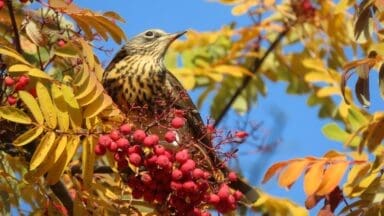
Established by the Game & Wildlife Conservation Trust (GWCT), more than 2,000 farmers and landowners take part every year in the GWCT Big Farmland Bird Count, collecting invaluable data during a two-week window in February, that helps track changes in the populations of farmland birds.
The results of this year’s GWCT Big Farmland Bird Count (BFBC) indicate a total of 358,913 birds, belonging to 125 species, recorded across 699,869 acres of farmland by 1,369 farmers, land managers and helpers.
The results indicate notable decreases in sightings of some species, including red-listed fieldfares which were down 52%, long-tailed tits which were down 27%, and curlew with a 25% drop, year-on-year. On a positive note, recordings of red-listed common gulls were up 112% and sightings of amber-listed kestrels had increased by 182%.
In total 145,681 red-listed birds were counted including 26 different species, of which the most abundant were starling, lapwing, common gull, linnet and fieldfare.
Of the 1,369 participating farms, 65% are in agri-environment schemes. Nearly 50% undertook supplementary feeding of birds in winter and many had planted wild bird seed mixes on their land to provide food, both of which are options in the government’s Sustainable Farming Incentive (SFI) scheme.
Andrew Goodall, a bird expert and enthusiast, who helps farmers in East Anglia with their surveys explained that this annual exercise is not about noting rarities, but that so much can be learned from watching common birds. He added that the count provides a valuable opportunity to take a snapshot of bird numbers on farms every year.
The GWCT’s Director of Advisory and Education Roger Draycott said that confirmation in the Chancellor’s Spending Review that funding for the Sustainable Farming Incentive had been secured until 2029 was critical to UK nature recovery. He said: “Of immediate concern are the several thousand Countryside Stewardship agreements that expire on 31 December – thousands of hectares of valuable habitat could be lost unless Government provides urgent reassurance to these farms that SFI will be available to them next year. To ensure further investment beyond that, we need to demonstrate as a sector that these schemes are delivering value for public money. One of the ways farmers can do this is by taking part in the annual BFBC.”
Draycott added: “We were delighted by the number of farmers across the UK who entered the BFBC this year demonstrating a strong engagement with the wildlife on their farms. Our farmland birds continue to decline nationally and we will only reverse that trend if farmers, who manage 72% of the UK’s countryside, are encouraged and properly funded to implement conservation measures on their land. Many of the options in the SFI are based on GWCT science. They are well-funded and well designed to fit in around modern farming systems and I would encourage farmers to apply for the scheme when it reopens.”
Bird count results in Wales, where 34 farmers and land managers counted a total of 4,565 birds – 81 species were identified, across 14,152 acres of farmland. The most abundant species spotted were starling, jackdaw, house sparrow, wood pigeon and robin. In total 1,784 red-listed birds were recorded, belonging to 16 different species. Of these the most abundant was starling.
In Scotland, 72 farmers and land managers counted a total of 13,345 birds, belonging to 97 species, across 77,962 acres of farmland. The most abundant species recorded were wood pigeon, jackdaw, chaffinch and rook. In total 3,667 red-listed birds were counted including 19 different species. Of these the most abundant was lapwing.

